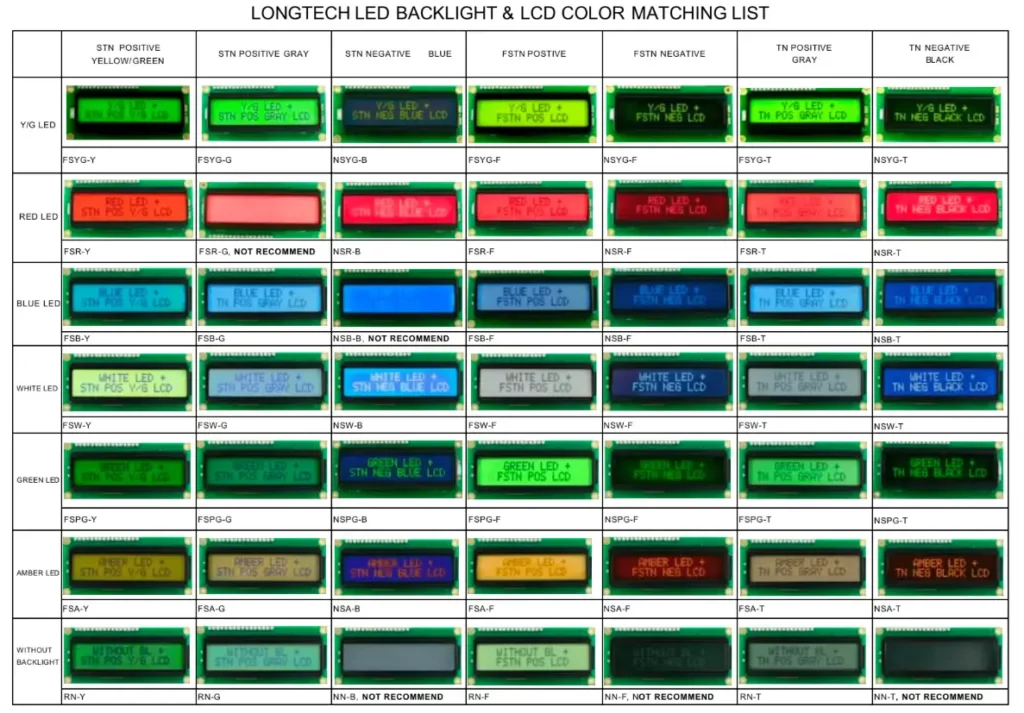Choosing the right character LCD display for your application is crucial for ensuring optimal performance and user experience. In the world of industrial LCD displays, where precision, durability, and efficiency are paramount, the stakes are even higher. As an expert at Longtech, I’ve seen firsthand how the right display can make or break a device’s success in the market.
Understanding the myriad of options available, the nuances of each technology, and how they align with your specific needs is the first step towards making an informed decision. Whether it’s for medical equipment, consumer electronics, or industrial machinery, the right character LCD display enhances readability, user interaction, and overall product reliability.

Embarking on this selection journey can be daunting, but I’m here to guide you through every step, ensuring you make a choice that not only meets but exceeds your expectations.
What is a Character LCD Display?
Character LCD displays are simple, low-power displays capable of showing text and limited symbols in a fixed font size. But what makes them stand out in the vast market of digital displays?

Understanding the Basics
Character LCD (Liquid Crystal Display) screens are designed to present characters and numbers using a fixed-format display matrix. Unlike graphical LCDs that can show complex images, character LCDs are optimized for displaying text in various applications, from digital watches to complex industrial equipment.
The Unique Advantage
Their simplicity offers a significant advantage – power efficiency and ease of use. Character LCDs consume less power than their graphical counterparts, making them ideal for battery-powered devices. Furthermore, their straightforward interface simplifies integration into projects, reducing development time and cost.
Learn more about What is Character LCD?
Why is Choosing the Right Character LCD Display so Important?
Importance of Compatibility
Selecting a display that is compatible with your application is crucial for ensuring seamless integration and operation. A misaligned choice can lead to increased development costs and delays.
Compatibility isn’t just about physical dimensions; it extends to communication interfaces, power requirements, and environmental resilience. A compatible character LCD display seamlessly integrates with your system, ensuring efficient power consumption, clear communication, and robust performance under varied conditions.

Balancing Performance and Cost
The perfect character LCD display balances performance requirements with budget constraints. It’s about finding a display that delivers on your needs without unnecessarily inflating costs.
This balance involves considering the display’s lifespan, energy efficiency, and maintenance needs against its upfront cost. A cost-effective display doesn’t cut corners on quality; instead, it aligns with your application’s essential requirements while offering the best value for your investment.
What Are the Key Factors to Consider?
1. Display Type and Technology
The choice between TN, STN, and FSTN technologies is crucial. Each has unique characteristics that can significantly impact your display’s visibility and performance.
Display Technologies Explained
TN (Twisted Nematic) panels are the most common and cost-effective, offering fast response times but limited viewing angles. STN (Super Twisted Nematic) improves on TN by offering wider viewing angles and better contrast. FSTN (Film-compensated Super Twisted Nematic) adds a film that enhances visibility under various lighting conditions.

Making the Right Choice
Your selection depends on your application’s specific needs. TN displays are suitable for simple, direct-view applications. STN and FSTN are better choices for devices that require readability under diverse lighting conditions and viewing angles, such as outdoor equipment or handheld devices.
2. Size and Resolution
Selecting the right size and resolution for your character LCD display is more than just matching dimensions; it’s about ensuring optimal readability and interface interaction for the end-user.
Size Matters
The physical size of the display affects how it will fit into your device and how much information can be displayed at one time. It’s crucial to balance the display size with the overall design to maintain usability and aesthetic appeal.
Resolution Counts
Resolution determines how much text can be displayed and affects clarity. Higher resolution displays can show more detailed characters, making them easier to read. Consider your application’s information density and readability requirements when choosing.
3. Interface and Compatibility
Ensuring your display is compatible with your system’s interface is critical. It affects not just the ease of integration but also the reliability of the data displayed.
Interface Options
Character LCD displays come with various interface options, including parallel, serial, I²C and RS232. Each has its advantages, with parallel being standard for simple applications and I²C ideal for those requiring fewer pins and simpler wiring.
Learn more about Serial vs Parallel Communication or I2C Communication Interface

Learn more about What is RS232?
Compatibility Is Key
Choosing a display with an interface that matches your system’s capabilities ensures seamless integration and communication. It’s essential to verify compatibility early in the design process to avoid costly modifications later.
4. Operating Temperature Range
The operating temperature range of a character LCD display is a critical factor, especially for devices used in extreme conditions.
Temperature Considerations
LCDs can experience reduced performance or damage outside their designed temperature range. Displays used in outdoor environments or industrial settings must withstand the conditions they will encounter.
Selecting for Environment
Ensure the display you choose has a suitable operating temperature range for your application. This consideration is vital for reliability and longevity in harsh conditions or outdoor use.
5. Power Consumption
For battery-powered or energy-sensitive applications, the power consumption of your character LCD display can significantly impact device life.
Energy Efficiency
Character LCDs are inherently low-power, but differences exist between models and technologies. Consider displays with LED backlights or those designed for low-power operation to extend battery life.
Balancing Performance and Power
Selecting a display with optimal power consumption for your needs can reduce operating costs and improve device usability in the field.
6. Display Mode (Positive and Negative)
The display mode, whether positive (dark characters on a light background) or negative (light characters on a dark background), affects readability and visual impact.

Visual Impact and Readability
Positive displays are typically easier to read in bright conditions, while negative displays offer a modern look and are more readable in low-light conditions. Consider your application’s typical use environment when choosing.

Making the Best Choice
Assessing where and how the device will be used can guide you in selecting the most suitable display mode for your application’s needs.

7. Light Mode: Transflective, Transmissive, Reflective
The light mode of your character LCD display determines its visibility in various lighting conditions, from direct sunlight to dark rooms.

Understanding Light Modes
- Transflective displays combine the best of both worlds, offering readability in both bright and low-light conditions.
- Transmissive displays are ideal for indoor use or where backlighting is always available.
- Reflective displays rely on ambient light, making them perfect for outdoor use or in bright environments.

Selecting the Right Mode
Choose a light mode that aligns with your application’s typical use case to ensure the best user experience under all lighting conditions.
Learn more about Transmissive vs Reflective vs Transflective Displays
8. Backlight Color
The backlight color not only affects the display’s aesthetics but also its functionality, influencing visibility and user interaction.
Color Choices and Their Impact
Different backlight colors can evoke various user responses and improve readability under certain conditions. For instance, blue or white backlights offer a modern look and are versatile under various lighting conditions.
Tailoring to Your Needs
Consider your application’s branding, user environment, and aesthetic requirements when selecting the backlight color. Customization options allow for alignment with corporate identity and user expectations.
Learn more about What is LED Backlight?

Connection Method: Rubber
The connection method affects the ease of assembly, durability, and maintenance of your character LCD display.
Comparing Connection Methods
Rubber connectors offer a flexible, cost-effective solution for many applications, while pin connectors provide a more durable, reliable connection, especially in environments subject to vibration or frequent handling.

Making the Informed Decision
Consider the assembly process, expected use conditions, and maintenance needs when choosing the connection method for your display.
9. Font Table
The availability of different font tables (English, Japanese, Russian, European, Hebrew) is essential for applications intended for international markets.

Importance of Font Diversity
A diverse font table ensures that your device can display the necessary characters for its intended audience, enhancing usability and accessibility.
Selecting the Right Font Table
Choose a display with a font table that meets your application’s language requirements, considering future needs and market expansions.
Longtech’s Diverse Model Approach
At Longtech, we understand the unique needs of each application. Our approach offers thousands of standard products without mould fees, ensuring you find the perfect match for your requirements without incurring unnecessary costs. Our commitment to quality, backed by a 3~10 year guarantee for 90% of our products, ensures your investment is protected.

Learn more about How to Make LCD Glass?
Customization and Support
Tailoring Displays to Your Needs For applications with specific requirements, our customization options allow you to tailor displays to your exact specifications. Whether it’s custom sizes, interfaces, or temperature ranges, we’re here to ensure your display fits your needs perfectly.
Unparalleled Support Choosing Longtech means more than just getting a high-quality display; it means having a partner dedicated to your success. Our experts are here to guide you through the selection process, offering advice and support to ensure your product exceeds expectations.
Conclusion
Selecting the right character LCD display is a nuanced process that requires careful consideration of your application’s specific needs. By understanding the key factors and leveraging Longtech’s diverse model approach and customization options, you can ensure your product not only meets but exceeds the demands of your target market.

